The Big Muff π Page
The Definitive Big Muff Resource and History
VISIT MY SWORDS, KNIVES and FANTASY ART WEBSITE www.kitrae.net
©Kit Rae. Last update July 2014
PART 1 • PART 2 • PART 3 • PART 4
WHY ARE THE TRANSISTORS LABELED IN THE REVERSE ORDER? - Note that Q1-Q4 and D1-D4 are labeled in reverse order from input to output on these schematics than they are on a typical schematic. This is due to the fact that they are printed in this order on the actial V1, V2, and V3 Big Muff PCB's. To keep it from being confusing for those reading their PCB's, since this is primarily a reference for vintage Big Muff owners, and to keep the EH tradition, we have used this order on all Big Muff schematics, including post 1980's Big Muffs and clones. I have also tried to keep the part numbers consistent from schematic to schematic.
VINTAGE DISTORTION modified Sovtek Big Muff - Behringer came out with a visually blatant, China made knockoff of the BMP in 2005, called the VD-1 Vintage Distortion. Despite the look and name, the circuit was not a clone of a V2 or V3 era BMP, but was based on the Electro-Harmonix small box, black Russian Sovtek Big Muff circuit. The sound is more on the kinder, gentler side than the Russian circuits. Smooth, but with the heavy low end removed by the modified tone section. The component values are very similar to the black Russian BMP, but the tone stage is different. The low pass functions the same, but the high pass pathways have been modified, removing most of the boomy bass, and some of the trademark Big Muff sound. R5 is a 100k resistor, instead of the common 22k high pass resistor, with a huge 2.2M resistor added at R27, creating a boosted mid range. Another interesting effect, I assume caused by the tone section mods, is that when the guitar volume is turned down, the distortion gates and sputters, something like a dying battery in a fuzz pedal.
Even though SMD components get a bad rap in the DIY builder community, it appears the small component size and tight circuit tracks in the Behringer offer noise benefits over larger, old fashioned thru-hole components. This pedal is almost completely silent, even at maximum gain. Something I have never found with any other Sovtek based Big Muff circuit.
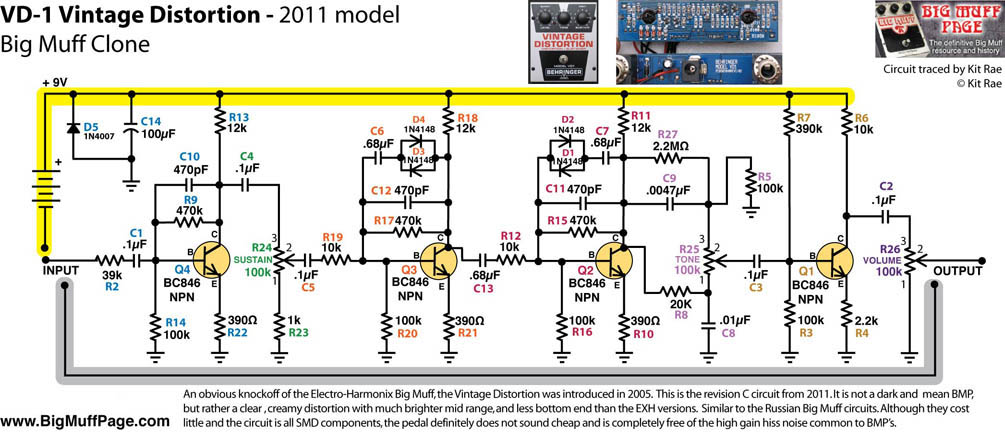
HOOF modified Violet Ram's Head Big Muff - In 2005 Jamie Stillman of Earthquaker Devices, in between managing tours for The Black Keys, made a superb modified Big Muff clone called the Hoof. Very close to the schematic below, the Hoof is often referenced as a modded green Russian BMP circuit. Indeed, its genesis was with Jamie reverse engineering a Russian BMP owned by Dan Auerbach of the Black Keys, but the original four knob version I own is actually closer to a violet era Ram's Head circuit with mods to the clipping and tone stages. The tones produced by the mods are similar to a Sovtek BMP however, but with much less bottom end. The original Hoof was a simple, three-knob clone, but the later version added an additional 25k mid range pot in the tone stage.
A popular mod to the BMP circuit was to trade the Silicon transistors out for Germanium transistors, which is basically what we have here in the two clipping stages. Ge transistors in the BMP circuit are said to smooth out the tone because they filter out more high frequncy sound than Si. They also reduce the gain/signal level, which has the affect of smoothing out the tone. Another popular BMP mod popularized around 2002 was to change the standard Silicon clipping diodes for LED's, which are essentially diodes, giving a different voice to the tone. LED's compress the signal less than Silicon, resulting in lower volume and a slightly cleaner and brighter distortion. The Hoof has been made with red, and later, clear LED's. Different colors/types of LED's produce slightly different variations on the clipping tone and gain. In the Hoof these two mods result in wide tone range that can go from a Ram's Head type tone, minus the bottom end, to a nasally Marshall type tone, with some sovtek Big Muff in between. It does not quite match the sound of any of those, but has its own thing going on, which is very clear and articulate. There is also a slightly less muffled cleanup when the guitar volume is turned down, and the pedal is slightly less noisy than a traditional BMP.
The Shift control is essentially the AMZ tone/presence control mod, and this is probably the best use of the AMZ tone control I have heard in a Big Muff clone, with a wide spectrum of useful tones across the pot sweeps. The volume pot is a huge 1M (1000k) and the sustain pot is 50k, rather than the standard 100k pots typically used in a Muff.

LARGE BEAVER modified 1976 Ram's Head Big Muff - In 2006 B.Y.O.C. (Build Your Own Clone) created a built-it-yourself vintage Big Muff kit called the Large Beaver that included all the parts to assemble a Big Muff. It could be built either as a V1 Big Muff (Triangle 72 #2 schematic on page 1), or a Ram's Head (Ram's Head 76 #1 schematic on page 2), two of the best sounding variants. The Beaver also included a tone selector switch, allowing you to choose the stock scooped mid range, flat mid range, boosted mid range, or tone bypass. The BMP mid range scoop is the main reason many people end up not getting along with the BMP. It can sometimes get lost in a band mix, or simply does not sound good with certain amps with a competing mid range. This mod makes the BMP very versatile, overcoming those issues.
Below is the Ram's Head 76 #2 schematic from page 2, similar to the one BYOC used, but better in my opinion, with a similar tone selector mod using my preferred values for the flat and boosted mids.
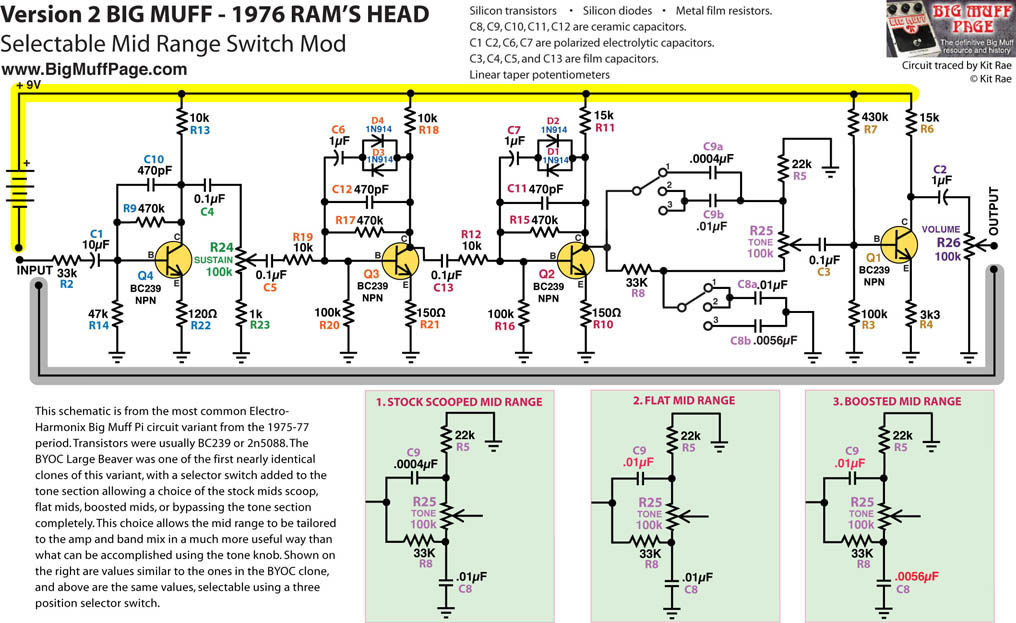
POWER BOOSTED BIG MUFF - The Electro-Harmonix LPB-1 (Linear Power Booster) is a simple and effective little booster circuit made by EHX way back in 1968. I have been playing around using it to drive or follow my Big Muffs in the signal chain for years, and it is one of the dream combos I always wished EHX would actually make (a Big Muff - Colorsound Power Boost combo is another). There was a Big Muff/booster combo clone made in 1971 called the Ace Tone Fuzz Master FM-3, but the booster stage was switched separately from the BMP circuit. In the early 2000's I started to see some boutique Big Muffs being made that included the LPB-1 built in, or a similar booster circuit like the AMZ mosfet booster, incorporated as an inline stage of the BMP circuit. The last stage of the Big Muff is basically the same as the LPB-1, so it seemed a natural idea to throw another one in front of the circuit with a gain pot, making a Big Muff with a preamp booster. Below is a trace of a custom modded BMP I found on ebay in 2005. A bit heavy on the saturation and low end for most people.
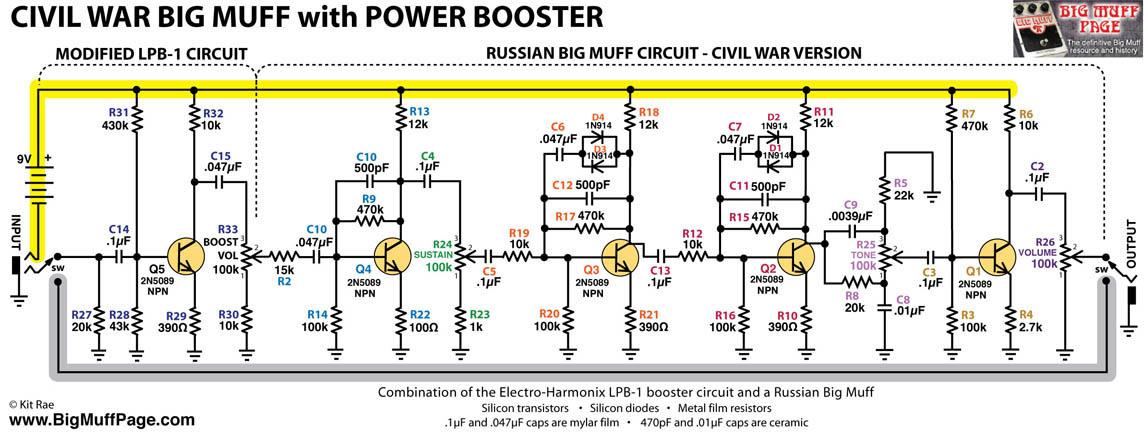
FUZZ BOOSTED BIG MUFF - Another version of the Civil War Big Muff with a pre-amp booster stage on the front end, slightly better than the one above. The booster here is based on one Jack Orman (muzique.com) came up with, similar to a single BMP gain stage, minus the feedback capacitor. This provides a disortion boost, but the clipping parts shown in red can be removed to give a clean boost to the Big Muff input stage like the LPB-1.
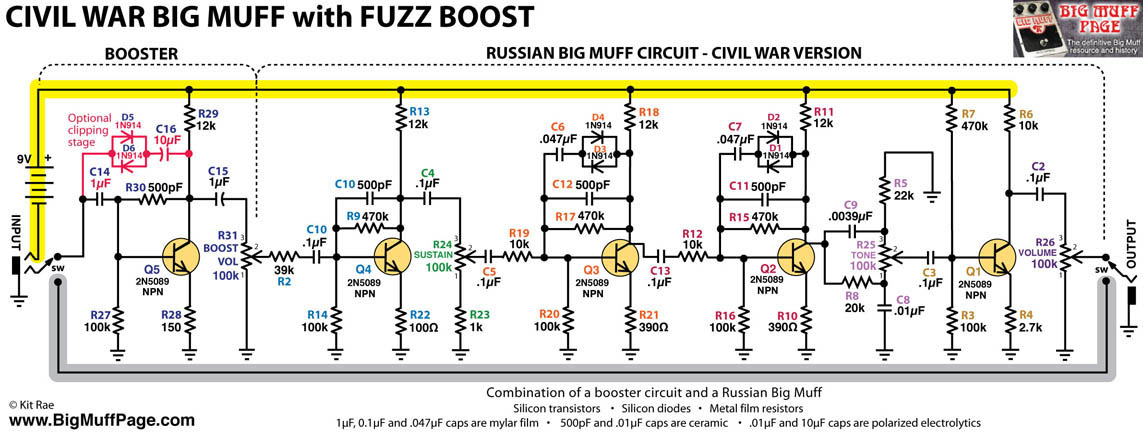
MUSKET modified Sovtek Big Muff - How do you make the Muff with LPB-1 Power Booster shown above even better? Refine the input saturation and add a bunch of trim pots to make it very tweakable. Blackout Effectors did just that in 2008 and the result is one of the most versatile Sovtek Big Muff clones out there, the Musket V2, shown in the schematic below. The Focus pot adjusts the LPB-1 saturation into the Big Muff input stage, similar to what the input switch on the Muff Diver (shown above) did. The Mids pot, a variant on the AMZ tone/presence control, lets you adjust the mid-range frequency scoop from flat to boosted. The Big Muff part of the circuit is simply a Black Russian with the .047uF clipping caps changed to .1uF to keep the bottom end in check.

COLOSSUS modified Sovtek Big Muff - MojoHand FX made an excellent Big Muff clone in 2011 called the Colossus. It is nearly identical to the Civil War Big Muff circuit, and MojoHand swiped the same tone circuit and mids pot layout as the Musket. Instead of a pot to set the input level like the Musket, the Colossus uses a three position EQ switch. The only other changes from the Civil War were the use of large 560pF caps at C11 and C12. This was marketed as being based on the Civil War Sovtek BMP, but those only used 430pF or 500pF at C11/12. Compared to the Musket V2, the tone section also has slightly larger caps at C9 and C14, and a slightly smaller resistor at R5, but I believe those same values were in one of earlier Musket versions, so they were likely just copied from that. Overall, I like the sound of the Colossus and the mids control range slightly better than the Musket.
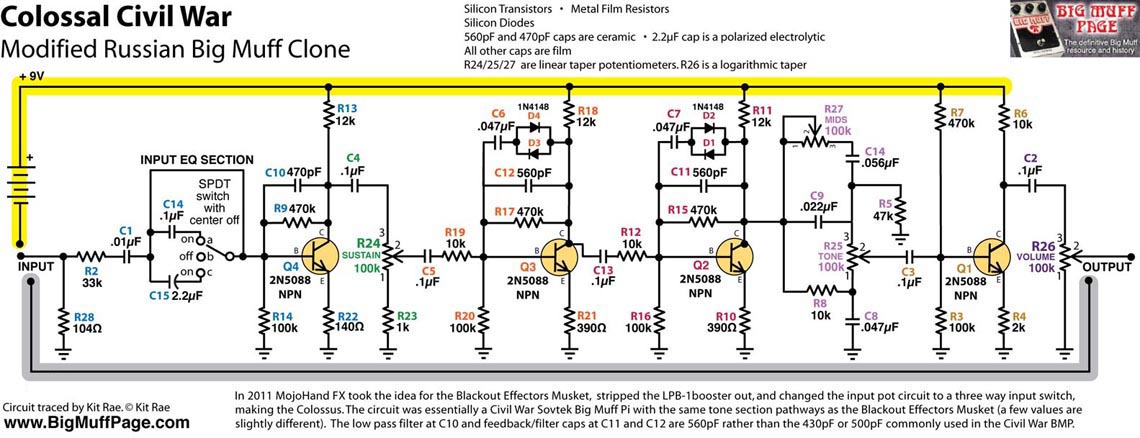
SUPERCOLLIDER modified Sovtek Big Muff - The Collider was yet another modified Russian Big Muff clone (discontinued), this one a tweakable, bass guitar friendly circuit, built by Earthbound Audio in 2008. Mark at Earthbound added a Depth pot at the input stage, similar to the Focus pot in the Muskett schematic shown above. The tone section has been modified to include a 50k mid range pot at R27, a variant on the AMZ tone/presence control, allowing adjustment to the mid-range frequency. Limiting resistors at R12 and R19 are half the size of the resistors in a Russian Big Muff, and feedback resistors at C12 and R15 are 1M (1000k), around double the size of a Russian Big Muff. This creates a lot more drive, crunch, and gain in each clipping stage than a traditional Russian BMP.
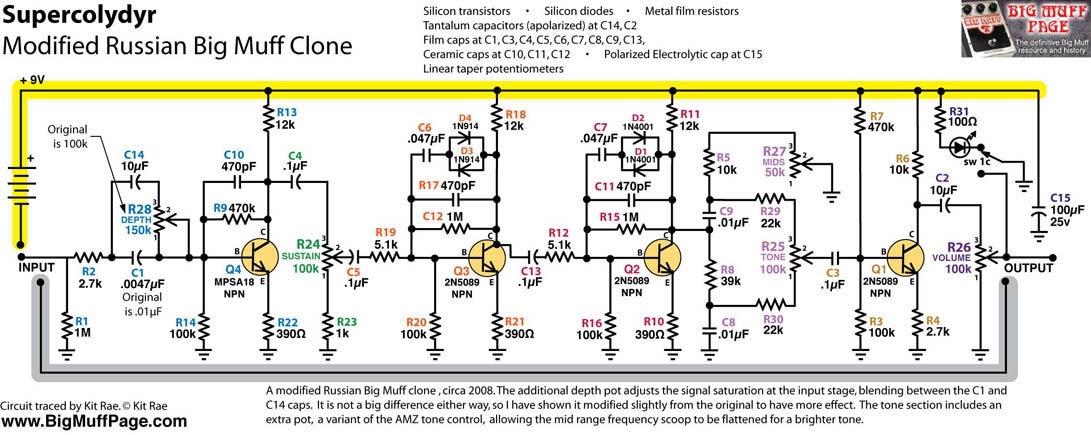
PHARAOH modified 47 Ram's Head Big Muff- The Pharaoh by Black Arts Toneworks followed a few years after the Collider shown above, but was apparently inspired by it. Both use MPSA18 transistors in Q4 and 2N5089 in Q1-3, along with tantalum input and output caps. The basic Big Muff part of the circuit in the Pharoah is very similar to the "47" Ram's Head BMP shown on page 1, with several mods that allow for a wide range of tonal divertsity. The input resistor in the first stage has been converted to a hi (39k) and low (390k) gain switch, affecting the low cut filtering in the input stage, but unfortnately also affecting the input signal level, causing a large volume difference between the two sides. The high side is basically the stock Big Muff input, and the low side allows for lower gain, overdrive-like tones.
A 25k pot was added to the tone stage in place of the R8 low pass resistor, yet another variant on the AMZ tone/presence control, allowing a boost to the highs. The low pass cap at C8 was enlarged to 2.2µF to balance the low pass filtering. The large cap and resistor at C9 and R5 on the high pass sides allow for less mid range scoop than the "47" Ram's Head.
An SPDT (on/off/on) switch was added to the second clipping stage to toggle between bypassing the diodes completely (a popular mod to the BMP circuit originating with the 1973 Supa Tonebender - violet Big Muff clone), or switching to either Germanium or Silicon diodes, another common BMP mod. The Germanium side gives a slightly different voice to the distortion than the traditional Silicon diodes, with a smooth overdrive-like character when the low side of the input switch is selected. The Germaniums also compress the sound slightly less than Silicon diodes, so there is a large volume cut when they are switched on. On average, Ge diodes start to clip at around half the voltage of Si, so the output level is around half. A third Ge diode was added to the Ge clipping loop to help bring the output level back up, but there is still a volume drop when engaged. The volume disparity between the switchable options makes switching between them impractical in a live situation (as does the blindingly bright LED) without having to adjust the volume, but the mods do allow for a much wider, well rounded range of sounds than a stock BMP.
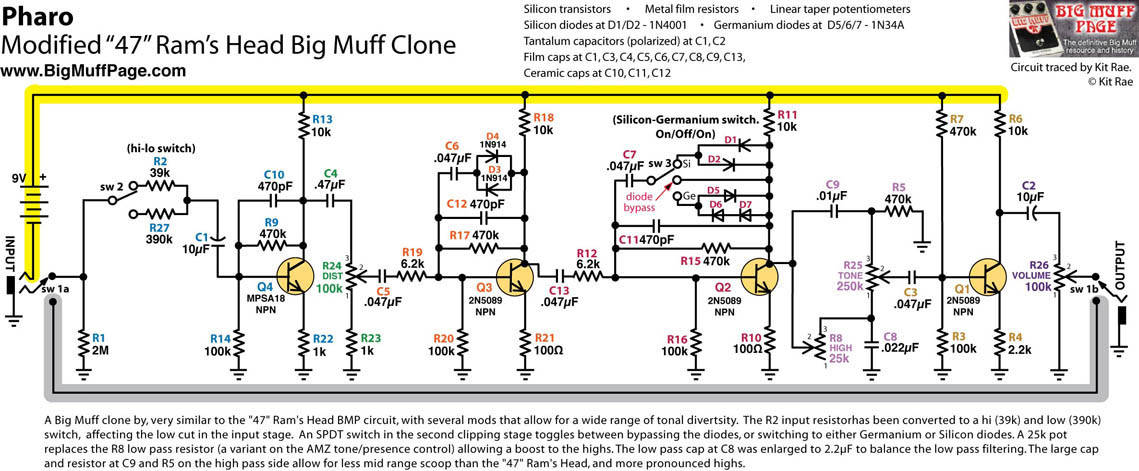
P19 / IRON BELL modified Big Muff with no mids scoop - Skreddy Pedals released the P19 in early 2012. MojoHand FX apparently liked the P19 circuit a lot (Marc at Skreddy generously posted his schematic online), because they swiped it later that year for their Iron Bell pedal. The Iron Bell version is the one traced here, minus the power filtering and LED components. The major difference from the P19 being that MojoHand replaced the mids switch with a pot and made some minor component value changes listed as follows:
- The original P19 has a 10k at R11 instead of 15k
- 0.047pF at C15 instead of 0.056
- 200Ω at R22, R22, and R10 instead of 140Ω, 120Ω, and 390Ω respectively
- 2.7k at R4 instead of 2k.
You will notice the tone section layout including the pot (labeled Colour) is identical to the Blackout Effectors Musket, only with different component values to keep it similar to the P19 mids hump sound. This tone section mod, which lets you adjust the level of the mid-range frequency boost, is a variant on the AMZ tone/presence control.
The small input cap at C1 makes the sound more articulate and helps reduce noise. The large emitter resistors at R22/R21/R10 and large feedback caps at C11/12 also help keep noise level from the BC550 transistors (used in the P19) low, and to help smooth out the tone. In a normal muff the tone tends to get muddy at low sustain settings because the higher frequencies get filtered out as the sustain is reduced. The .0022µF bleed cap across the sustain control at C16 filters out more lows and retains highs for a more balanced sound at low sustain settings, similar to a treble bleed cap in a guitar. The additional 560pF cap across the volume pot at R28 operates the same way. The large .33uf cap after the tone section at C3 (typically .1µF) tightens up the low end. I show the common 1N4148 diodes in this schematic, but Marc says he uses a special blend of mismatched diodes for an ever so slight assymetric clipping in his pedal.
The component values of the P19 are not really based on any existing EHX Big Muff, they are just Marc's unique blend of the Pi, with each stage a mix of his custom values to get the desired tone. The sound is very smooth, with a boosted mid range (no scoop), and not as bassy as a typical muff. It was made with David Gilmour's Pink Floyd Big Muff tones in mid, similar to the Skreddy Pink Flesh and Pig Mine, and stands out really nicely in a band mix. Marc said he was inspired by the Pete Cornish P-1, but this is more of his creation than a P-1, which is more of a Ram's Head sounding circuit.
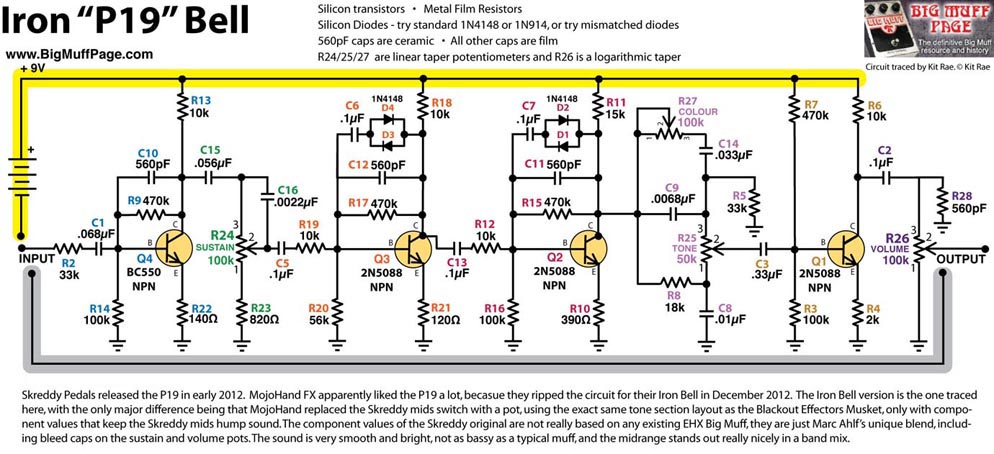
VERSION 9 "NYC REISSUE" BIG MUFF PI - Four versions of the circuit exist
V9 "NYC REISSUE" BIG MUFF - I'll finish off this circuit evolution article going back to the first version of the reborn Big Muff Pi from 2000 (discontinued). Note that this schematic is NOT the circuit from the current current version of the BMP made by Electro-Harmonix, or from any other current version. It also does not include the power filtering, reverse polarity protection, and LED components, just the audio circuit. Also note that the transistors are actually labeled in reverse (Q1-Q4) on the actual circuit board from what is shown on this schematic.
This 2000 reissue version was a new take on the BMP circuit from EHX designer Fran Blanche, from when EHX was just restarting as a company again in the USA. The component values appear to be a mix of the late 70's V2 BMP, with a deeply mid-scooped tone section from one of the early V1 BMP's, and 390Ω emitter resistors in the clipping stages from a Sovtek BMP. The 3003-A revision from 2001 was basically the same. I like the sound of this one a lot. EHX decided to change the circuit in 2007, then again in 2008, so the current model has a different, heavier and doomier sound.
Previous USA Big Muffs used 1N4148 Silicon diodes, but EHX changed to 1N6263 Silicium Schottky diodes for the reissue in 2000. These compress the sound more and make it slightly more trebly, contributing to the different sound of the reissues. EHX changed back to 1N4148 by 2008.
There were, and still are, complainers who say the reissues "do not sound as good as the originals", but as you can see from this article, there never was one "original" to reference as a basis for the sound. The Big Muff Pi is an evolving and ever changing circuit, and this was just the latest evolution. I have no doubt that when this version is 25-30 years old, it will be considered a collectible classic, just as the 1970's Big Muffs are considered today.
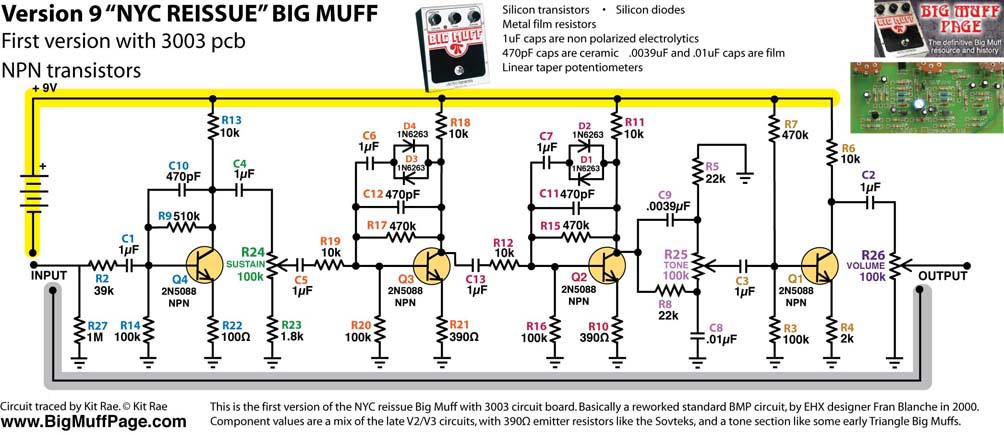
STRIP BOARD LAYOUTS - If you are a hobby pedal maker or are handy with a soldering iron and want to build your own, or experiment with these different versions and mods, a compact strip board layout for the BMP can be found at the Turretboard.org website. The layout is well drawn and easy to follow. Part numbers correspond to the part numbers on the Circuit Guide, and all schematics on this website. Through-hole circuits with large capacitors, resistors, diodes, and transistors, are rapidly becoming a thing of the past for mass production pedals. Everything seems to be transitioning to micro sized SMD components, machine populated onto circuit boards. Strip board is a fun way to play around with the old school method of making pedal circuits. Be aware that the startup costs for equipment, parts, and time involved are probably higher than simply buying an Electro-Harmonix BMP or a BMP clone.
I will be adding more schematics of other discontinued production and boutique BMP clones in the future. I will not post the schematics of anything in the current EHX line, like the current Big Muff, Tone Wicker Big Muff, or Bass big Muff, so don't look for them here.
Kit’s Secret Guitar, Gear, and Music Page
Guitar stuff, gear stuff, soundclips, videos, Gilmour/Pink Floyd stuff, photos and other goodies.
Copyright Kit Rae.
VISIT MY SWORDS, KNIVES and FANTASY ART WEBSITE www.kitrae.net
This page is not authorized, affiliated, or associated with Electro Harmonix in any way.
Website and contents ©2007 and ©2012 Kit Rae. All rights reserved. Linking to this website is allowed, but copying the text content is strictly prohibited without prior authorization. No part of this work may be reproduced, stored in a retrieval system, or transmitted in any other form, or by any means, electronic, mechanical, photocopying, recording, computer networking, or otherwise without prior permission in writing from the copyright holder(s).






